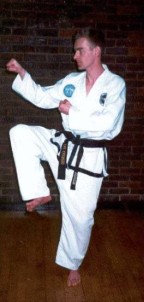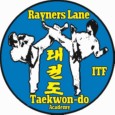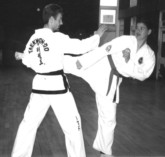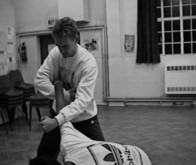I also used to train with a Shotokan black belt and was always very aware that a single, but very important element was missing from Taekwon-do training, that of pattern application. Not the knowledge of the movement, but the actual practice of it. Something that has now been thankfully rectified when I train and teach today. Patterns should be practised solo, broken down as fundamental exercises and practised in pairs or groups that allow the applications of each move to be felt and used against a real opponent. How many people have reached black belt in Taekwon-do or win medals at pattern competitions but do not know the nerve-strike contained in pattern Toi-Gye, the release techniques from Choong-Gun or Po-Eun or even the pressure points in Chon-Ji (Yes they are there), plus the many others. Since the time I left my old association, which was adamant about perfection in patterns, I have sought more to understand the applications and added this to the knowledge taught already by my instructor Mr Bryan. This in turn has lead me to find out more about the 1st generation instructors that were originally under General Choi, but have now left. Many of whom were originally responsible for the technical direction of ITF style Taekwon-do. The way they teach (and were taught) is quite far removed from what many instructors teach today. Luckily, wether simply by chance or realization of my instructor, my own training was not to far from how Taekwon-do was originally perceived. Mr Bryans (and Mr Peppers) extra-curricular training (if you like) has afforded me something very valuable. That of looking deeper into everything, staying open minded and (possibly to their annoyance) questioning everything I didn't understand and even that which I did. I, like many before me, went through the learning stages of patterns practice. First you learn them as accurately as possible but with no regards to technical application. By as accurately as possible I mean that your knife hand guarding block is correctly positioned etc. but not necessarily effective in its own right. Then you learn them simply because they are part of the syllabus and are content to stick with 'This is a block, this is a strike' and again making them as accurate as possible. Then you either carry on like this, or you dismiss them as having no relevance to self defence (as many students do) and simply being tradition. The former people often giving up Taekwon-do or any art which involves similar practices (such as kata) or concentrating solely on sport style sparring, assuming that this is more akin to self defence than patterns or anything else contained within Taekwon-do. Even with the knowledge of the applications it is of no use to simply tell the student the application, rather than let them practice it, as this will obviously be of no use should the student need to use it. Many have forgot the old adages of "One strike is sufficient for victory" or "One strike, one kill" and lose this important point in their quest for student trophies, where many people see a good Taekwondoist as the one who brings home the gold. But if we work with the 'One Strike, One Kill" philosophy then why do many students consider a patterns with 24, 28, or 45 movements in it to be a way of fighting, then dismiss it as impractical. Of course if you looked at a pattern in this way then it does seem impractical with regards to self defence, after all who fights using 20 walking stances ! But patterns aren't meant to be viewed this way. A simple example of what I mean can be seen in the first two movements of pattern Dan-Gun. If attacked with a straight punch and you block with a knifehand, the strike would also be a straight punch with the added momentum of the body moving forward, thus increasing the punches power considerably, the fact the it is a high section punch means that it possibly travels over the attackers arms and into its intended target. This of course is the simplest application of a knife-hand block and high section punch, there are others. I was taught that a block (or most of them) were actually designed to damage your opponent, so the block does the damage and the strike follows in for the kill (so to speak). This makes patterns a collection of block and strike applications or blocks and counter-attacks. Obviously learning 500 variations of these is very hard to remember, so a pattern becomes a collection of these moves and all the patterns makes a library of self defence that's easier to remember. With the number of different applications for each movement, the number of defences increases considerably, but remains in an easy to remember format (provided you practice regularly and correctly). Like I said above, the sport side of Taekwon-do has its place (both in club sparring and competition). If your first strike doesn't come off as planned then the ability to keep on flowing is a major advantage, as are that sense of distancing and timing, plus the butterflies that competition produces in juniors and all that goes with it. That is why I have always seen competition as simply another part of training, but not a means to an end. I myself competed for many years, with a good success rate, so I know the benefits of competing. Apply the pattern applications as they should be taught and you have a formidable arsenal of strikes, kicks, locks, breaks and release techniques, even throws. Add to that an open minded instructor and the world is you oyster. In the outside world, add this knowledge and training to the works by Geoff Thompson and such, with regards to adrenaline responses etc. and your chances of surviving an encounter are greatly increased. Some might say this is not Taekwon-do, but if Taekwon-do is a scientifically formulated art, then what is wrong with taking on board these break throughs. To me, Mr Thompsons 'fence' is one of the most important techniques devised within the last 20 years (may be longer). If it really bothers anyone, just modify your knifehand guarding block - simple. The propagation of patterns as being useless or simply traditional stems from many areas. At the top of the tree lies the syllabus. Obviously this must be adhered to and if parts of the original teachings are missing then who's fault is that ? Because students must perform patterns so accurately more time is taken into making it look perfect, as opposed to actually understanding the techniques or allowing the techniques to become effective in their own right. Knowledge of the various application of movements makes pattern practice not only more enjoyable, but more realistic and with the correct training methods an instructor can teach his students to use and utilize Taekwon-do techniques as they were meant to be use, as a method of unarmed self-defence. One final point I would like to make is the opinion that "If Taekwon-do is a kicking art, why do the lower grade patterns have either none or just basic kicks in them". I good point I grant you, a point so considered by others that they even change the patterns in order to stay more 'true' to Taekwon-dos own identity. This is of course personal belief and I cannot comment on this but I do offer this for consideration. Although Taekwon-do's roots through other arts obviously has something to do with it, may be General Choi and the other Masters who helped devise and create the patterns simply knew that hand techniques are easier and quicker to master (for want of a better word) than kicking techniques, thereby equipping the newer student with useful skills sooner, rather than latter. |

Many a time I have heard the question posed 'How do patterns relate to real self defence ?" or the statement "Patterns are simply Taekwon-do shadow sparring" etc. Or even worse "We teach patterns because they are traditional, but sparring is really the practical side". Surely, as a martial arts instructor you must have self belief in what you are teaching. If you have no belief in the practicality of patterns then why teach them, its like teaching a low section block and saying 'this is how its meant to look, but this one is more practical", whats the point in that. Over the years I have seen many exceptional performances of patterns by the likes of Mr Ray Smeathers, Miss Than Ying Au, Mr Mark Hutton, Mr James Hogan (all from different Associations) and a few others. Exceptional in the fact that they actually make the moves of the pattern look like they would work for real, but remain technical, so emplify how patterns should be. Many others do good patterns, but they don't emplify that 'realness' that the above did, technically they are correct, but is that enough ? The point many instructors seem to miss is what patterns are actually intended for. Many clubs simply breeze through patterns practice either trying to ensure that the side kick in Hwa-Rang for example is not an inch out of place or simply just going through the motions with regards to learning the movements but not learning the meaning and applications. How can every bodies pattern look identical when we are all different shapes and sizes ? Similar maybe, but not identical. Surely there must be something more to practising patterns ? I feel the effort of making patterns look good, be understood and remain practical should be given equal measure. Many are content though with simply learning the moves, grading and learning the next pattern. Or teaching a class that's 90% sparring orientated, relegating the patterns to the last ten minutes of class simply because they are part of the syllabus. Or the student who is guilty of practising their current grade pattern, but simply running through their previous ones only when requested, to simply remember it in case they are asked to perform them at their next grading. I too was guilty of this to a degree, as are all coloured belts. The yearning for that next grade as a junior overwhelms what we are actually being taught. I trained under two instructors simultaneously, with two very different teaching methods, but the same goal, that of achieving the required standard of a black belt grade, but at the same time producing a competent martial artist. Gradings came and went so quickly as a junior that there was never time to look in depth at a pattern, as being a certain grade for a short amount of time never really lets a student settle into the grade properly, allowing time only to get the pattern as correct as possible, rather than to understand its purpose. This is even more true today with grading times shortening considerably for some reason. Therefore students must be taught to re-evaluate their patterns after a grading and that's why I practice Chon-ji with more intensity now than I ever did as a yellow tag, because I understand how important basics are and how important repetition is to make a move effective, plus I actually know why I'm doing each move and what I am trying to achieve with practice. I teach my students to learn the patterns to the best of their ability, then after a grading to use the patterns they have learnt simply as part of their training. Dan-Gun is no longer a yellow belt pattern but part of training. Each of the patterns teach different things and in order to maintain these qualities they must all be practised in equal measure. To a blue belt Dan-Gun should be no less or no more important as Yul Guk. One of my instructors, Mr John Pepper, was very open minded with regards to other styles and often taught the application of pressure points and arm/wrist locks etc. This openness has followed through into myself. My other instructor, Mr David Bryan has always been very pro-Taekwon-do, choosing instead to seek the answers within the art, rather than outside of it. This was emplified when myself and another student turned black belt and he told us to re-examine our patterns and look for more than a single application to each of the movements contained within the pattern, something I still do and teach today. Many moves within the patterns contain two, three or even more applications, which can be utilized depending upon the circumstances. Low section block, for example, is taught with five applications in my classes and that's considered a basic technique. All five of these applications are taught without altering the way the block is practised at all. |
GO TO |


SECTION 1 |
GO TO |
ARTICLES Patterns: Are You Missing The Point ? by Stuart Anslow III As printed in Taekwon-do & Korean Martial Arts Magazine (March 2001 Issue) |


Nine Shape Block Application |

Mr David Bryan, 5th Degree |
